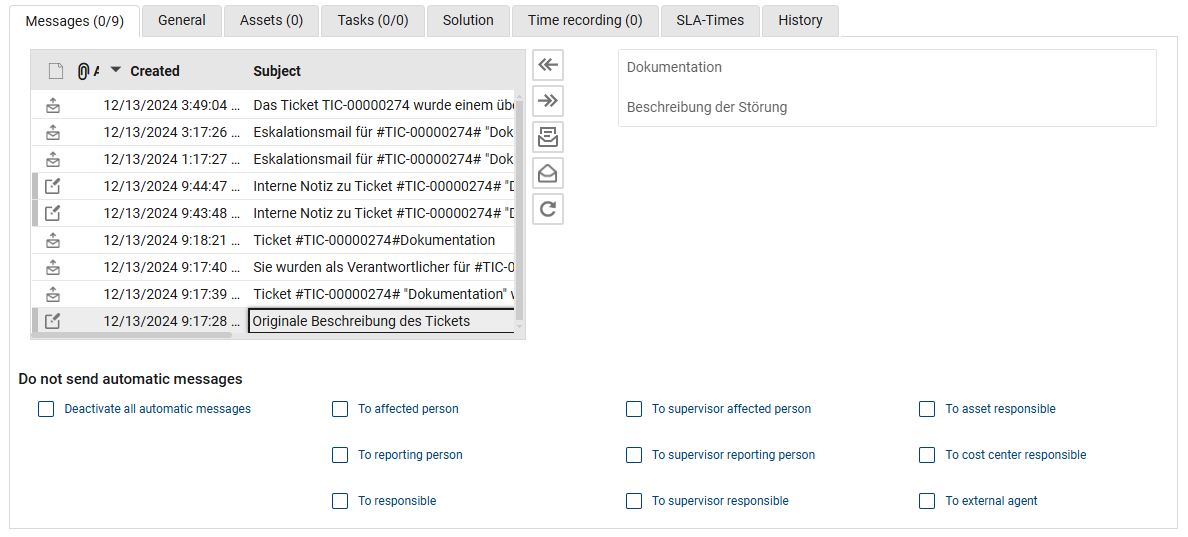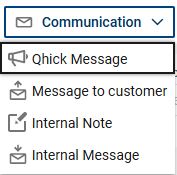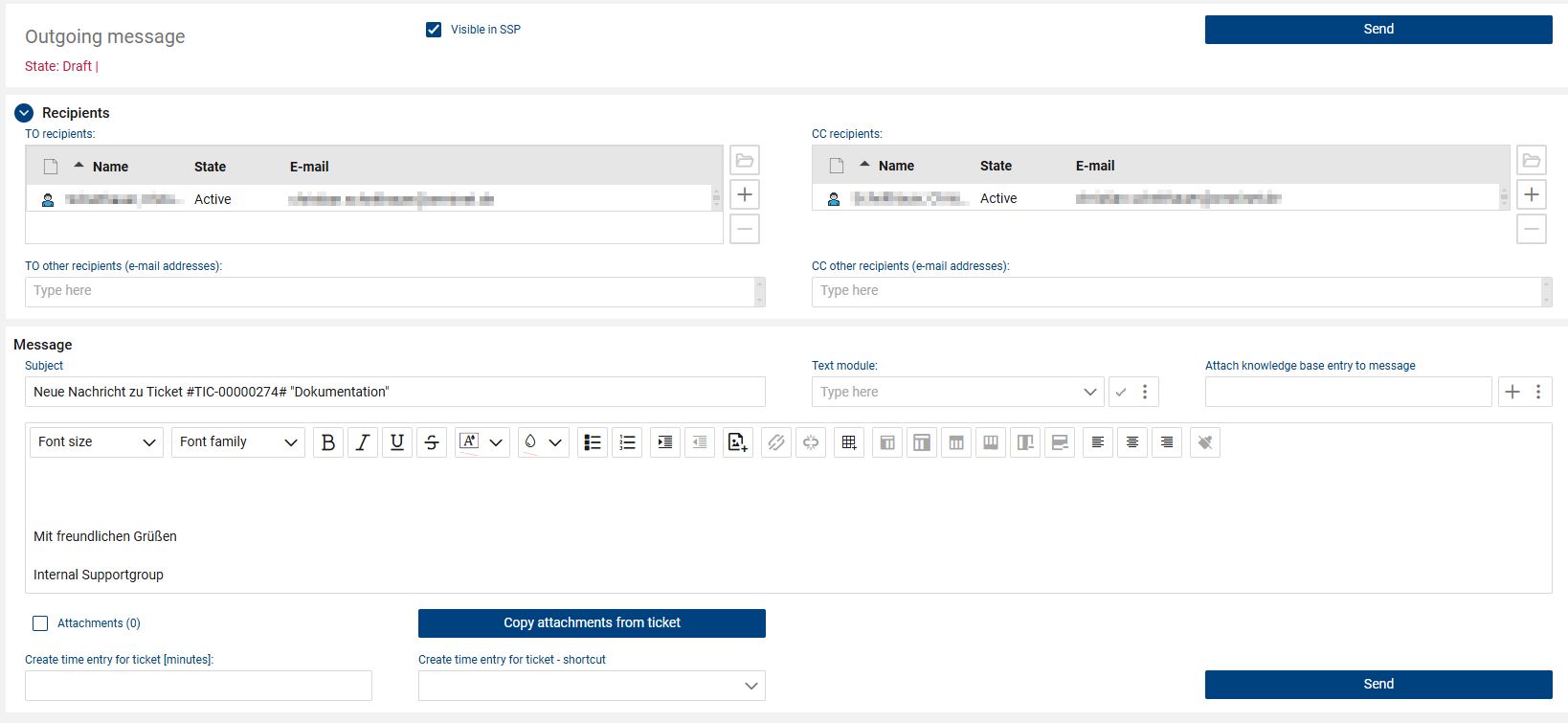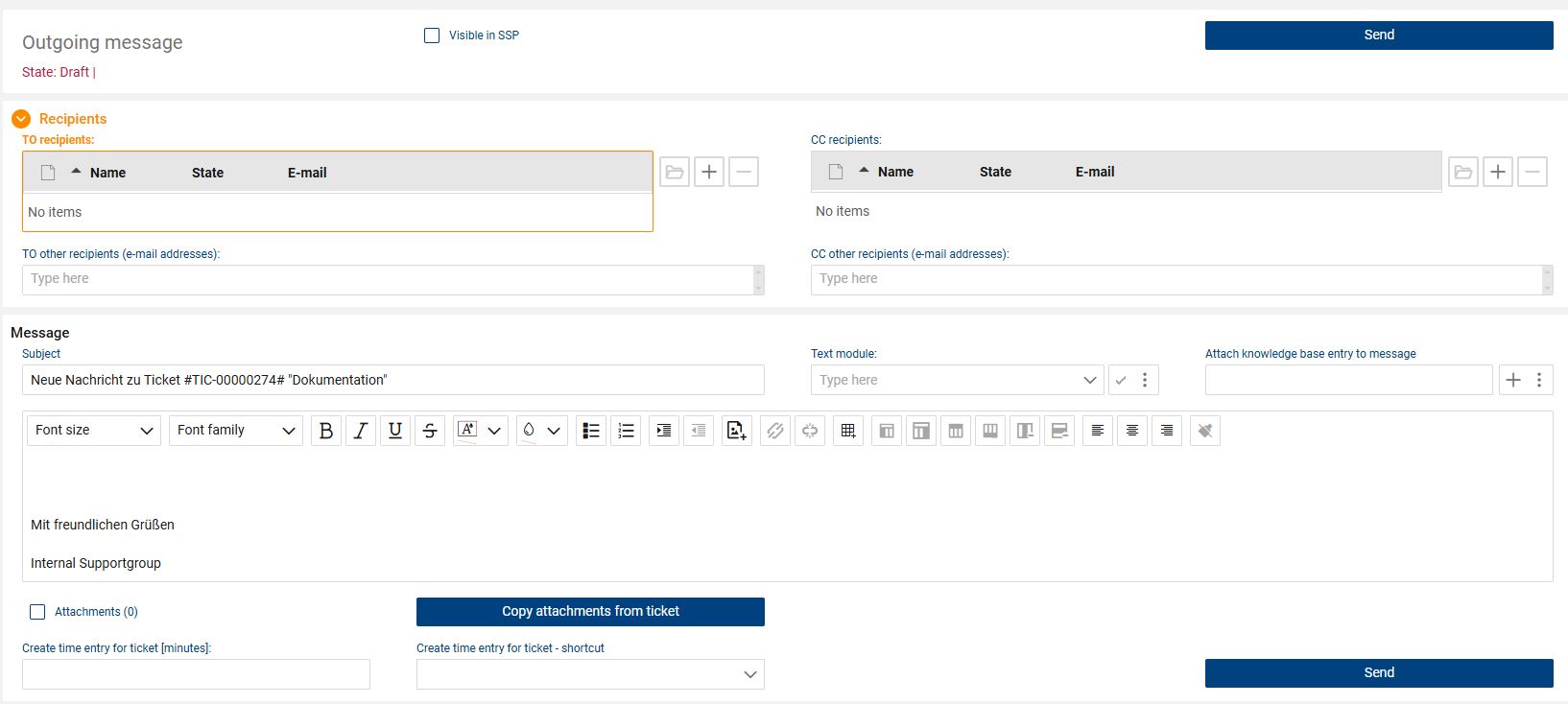This section contains the functions related to communication during ticket processing. Each message that is manually written by a user or automatically generated by the system (incoming or outgoing) for a ticket is displayed in an overview list in the "Messages" section.
The following message types and message list functions are available:
•Message to Customer: This function opens a new message in which the reporting and/or affected person is automatically stored as the recipient. The message is sent as an e-mail and then displayed in the Self-Service Portal.
•Internal Message: You open a new message, any recipients can be entered, e.g. to request help for this ticket. The message is sent as an e-mail and is not displayed in the Self-Service Portal.
•Forward: A flagged existing message will be forwarded to any recipients via e-mail and will not be displayed in the Self-Service Portal.
•Answer: A marked existing message can be replied to directly, with the creator of the existing message entered as the recipient. The message is sent as an e-mail and optionally displayed in the Self-Service Portal.
•Internal Note: The ticket editor can create a note and save it in the ticket. The note is not displayed in the Self-Service Portal. Notes cannot be forwarded or answered.
•Open Message: A selected message is opened.
•Read: Sets all marked unread messages to the "Read" state.
•Refresh: This function updates the message list if new messages were added during ticket processing. The system does not update certain new messages automatically.
The list contains creation date, subject, sender (or creator) and recipient, if a recipient exists. Incoming and outgoing messages as well as notes are displayed with a corresponding icon.
If a new message is only saved but not sent, it is saved as a draft. Drafts are displayed in the list with red italic font and an edit icon.
If there is an attachment to the message, the attachment icon (paper clip) is displayed:

Every e-mail sent about a ticket has a reference to the ticket (ticket number) in the subject. If the recipient replies to the e-mail and does not delete or change the ticket number from the subject, the reply is automatically reassigned to the ticket and the ticket owner (or responsible group) is informed via e-mail. This e-mail information also includes a direct link to the ticket and only occurs when the first new message in a ticket is received.
Optional: Quick message to affected person / reporting person:

The administrator can optionally display the function for creating a quick message to the customer in the form. This is a text field with a button for sending, an optional attachment field, and the function for inserting a text module.
When the message is sent, an e-mail is sent to the person concerned and, if there is a different person, to the person who reported it, and the message is also displayed in the Self-Service Portal.
The function is used to make the most frequent form of communication (the one with the customer) very fast and efficient. The same function is also possible at any time via the message section itself.

•Selection Text module: Via the selection field, all text modules individually stored by the administrator can be selected, or own text modules can be created. Via the checkbox "user-specific", these can only be used by the logged-in user. The administrator can see all text modules and, if necessary, make them available to all users as well as ticket type specifically. Text modules can be adapted or deleted at any time.
The original description of the ticket is always displayed as the first entry in the message list and is thus fixed for later revision, so that the original request can be compared with the later description, if necessary.
The available manual message options can be selected via the buttons above the list. The respective preassigned message form then opens for further editing, caching as a draft or sending.
Below the message list, there is a preview field. As soon as you select a message from the list, the text content is displayed as a preview. This allows you to quickly read through the messages without having to open each message individually.
Messages are displayed in the list as unread (bold font) or read (normal font), as well as in the draft italic font state. Opening a message or creating a new message automatically sets the message to read.
The default sorting of the messages is comparable to Outlook etc.—descending and starting with the newest message. With the usual click on the column header of the date field, the sorting can be changed temporarily.
The message form has the following functions:
•Visible in SSP: For each message sent, you can optionally decide whether it should also be visible in the ticket in the Self-Service Portal. The check mark is automatically preset for messages to the "Reporting person/affected person".
•Recipients: In the "Recipients" section, any recipients (also CC recipients) can be added to a message. These can be selected from the master data as well as entered directly as other e-mail recipients in the additional field below the recipient lists.
•Subject: The subject will also be applied as the e-mail subject. By default, this contains the information on the ticket number, unless defined otherwise by a message template, and should not be removed, as in other ways, a response from the recipient can no longer be automatically assigned to the ticket.
•Selection text modules: Via the selection field, all text modules individually stored by the administrator can be selected, or own text modules can be created. Via the checkbox "user-specific", these can only be used by the logged-in user. The administrator can see all text modules and, if necessary, make them available to all users as well as ticket type specifically. Text modules can be adapted or deleted at any time.
•Knowledge base entry: Optionally, an entry from the knowledge base (released and active for customers) can be attached to the message. After selection, a note text and a web link to the knowledge base entry will always be copied at the very end of the message text. Several knowledge base entries can be added one after the other, but only the last entry will be included in the ticket. ATTENTION: Even if the respective knowledge base entry is set to inactive at a later point in time, it can still be accessed via the link in the e-mail.
•Message text: Here, you can write a free text and use the text formatting. ATTENTION: Depending on the e-mail system used, not all text formatting may be displayed visually identical in the e-mail.
•Attachment: If necessary, any attachments can be attached to a message.
•Copy attachments from ticket: The button copies all attachments that are present in the ticket to the attachment of the message. If necessary, attachments that are not required can be removed again.
•Create time entry: When sending the message, a time entry can be created for the ticket at the same time. This is helpful if you have composed longer messages, and you do not want to process the ticket further for the time being after sending the message. You can either enter minutes individually or select a predefined minute value from the quick selection.
•Send: By clicking the "Send" button, the message is sent with all entries made. Afterwards, it is saved in the ticket list as an outgoing message.
•Internal Note: The ticket editor can create an internal note at any time. The message form will then be displayed without a recipient. The note is only visible internally and cannot be sent. By saving the note, a time entry can be recorded as well.
•Function message draft: Any message or note can be saved as a draft. Use the "Save" or "Save Draft and Close" buttons for this purpose. The message is not sent, or the note is not saved in a way that can be changed until you "Send" or, in the case of notes, "Save Final". Each message that is still in the "Draft" state is displayed in the message list with italic font and an editing icon.
Example for "New Message"

Example for "New Message (internal)"

Example for Notes:

|
Note: All e-mails from the "Messages" section are sent via an e-mail box assigned by the administrator, i.e. for the recipient of the message only the name of the e-mail box or the name defined is displayed as the sender. Under "Administration/User Settings", the user can store a personalized e-mail signature that is used by default. Likewise, the administrator can specify a central e-mail signature for the company, a department or a group. |